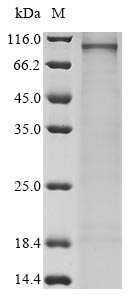To produce recombinant human Semaphorin-3G (SEMA3G) in E. coli, the gene of interest (23-782aa of human SEMA3G) is co-inserted into an expression vector with an N-terminal 10xHis-tag and C-terminal Myc-tag gene, which is transformed into E. coli cells. These cells are cultured to induce protein expression. After reaching sufficient growth, the cells are lysed to extract the recombinant SEMA3G protein. These proteins are purified through affinity chromatography. The purity of the protein is confirmed using SDS-PAGE, over 90%.
SEMA3G is a secretory protein that belongs to the class 3 semaphorins, which are involved in various physiological processes. In human white adipose tissue, SEMA3G expression is associated with obesity and metabolic syndrome, indicating its involvement in adipose tissue pathophysiology [1]. SEMA3G has been identified as a tissue-specific secretory factor in the lung and has implications for inflammation and cancer [2]. Studies have shown that SEMA3G may regulate adipocyte differentiation and be linked to high-fat diet-induced obesity [3]. Furthermore, SEMA3G is downregulated in brain microvascular endothelial cells, suggesting a role in axonal guidance through interactions with neuropilin-2 [4]. In diabetes, SEMA3G has been implicated in modulating angiogenic responses, with its transcription being regulated by the methyltransferase SETD7 through chromatin modifications [5][6][7]. The absence of SEMA3G has been associated with enhanced expression of inflammatory markers in diabetic nephropathy, affecting podocyte structure [8].
References:
[1] A. Saeidi, M. Saei, B. Mohammadi, H. Zarei, M. Vafaee, A. Mohammadiet al., Supplementation with spinach-derived thylakoid augments the benefits of high intensity training on adipokines, insulin resistance and lipid profiles in males with obesity, Frontiers in Endocrinology, vol. 14, 2023. https://doi.org/10.3389/fendo.2023.1141796
[2] J. Zhang, J. Ahn, Y. Suh, S. Hwang, M. Davis, & K. Lee, Identification of ctla2a, defb29, wfdc15b, serpina1f and mup19 as novel tissue-specific secretory factors in mouse, Plos One, vol. 10, no. 5, p. e0124962, 2015. https://doi.org/10.1371/journal.pone.0124962
[3] M. Liu, S. Xie, W. Liu, J. Li, C. Li, W. Huanget al., Mechanism of sema3g knockdown-mediated attenuation of high-fat diet-induced obesity, Journal of Endocrinology, vol. 244, no. 1, p. 223-236, 2020. https://doi.org/10.1530/joe-19-0029
[4] A. Calabria and E. Shusta, A genomic comparison of in vivo and in vitro brain microvascular endothelial cells, Journal of Cerebral Blood Flow & Metabolism, vol. 28, no. 1, p. 135-148, 2007. https://doi.org/10.1038/sj.jcbfm.9600518
[5] S. Mohammed, S. Costantino, A. Akhmedov, S. Ambrosini, G. Karsay, P. Brownet al., P736histone marks induced by the methyltransferase setd7 modulate angiogenic response in diabetes, European Heart Journal, vol. 40, no. Supplement_1, 2019. https://doi.org/10.1093/eurheartj/ehz747.0340
[6] S. Mohammed, S. Costantino, A. Akhmedov, G. Karsai, S. Ambrosini, G. Spinettiet al., A chromatin signature by the methyltransferase setd7 regulates semaphorin-3g transcription and angiogenic response in diabetes: insights for personalized epigenetic therapies, European Heart Journal, vol. 41, no. Supplement_2, 2020. https://doi.org/10.1093/ehjci/ehaa946.3757
[7] S. Mohammed, Targeting the histone methyltransferase setd7 rescues diabetes-induced impairment of angiogenic response by transcriptional repression of semaphorin 3g, Cardiovascular Research, vol. 120, no. Supplement_1, 2024. https://doi.org/10.1093/cvr/cvae088.158
[8] T. Chang and J. Chen, The role of chemokines and chemokine receptors in diabetic nephropathy, International Journal of Molecular Sciences, vol. 21, no. 9, p. 3172, 2020. https://doi.org/10.3390/ijms21093172






